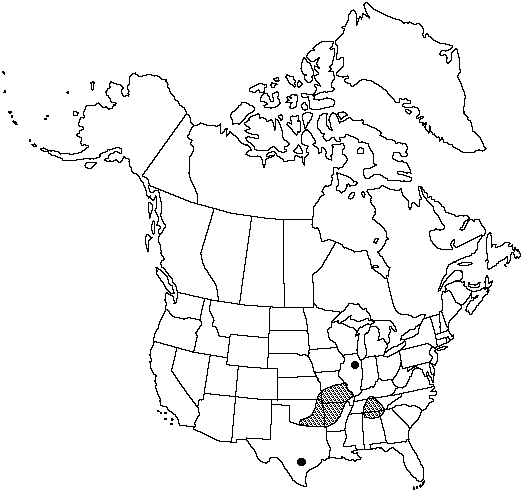Difference between revisions of "Isoëtes butleri"
Bot. Gaz. 3: 1. 1878.
Common names: Butler's quillwort
Treatment appears in FNA Volume 2.
FNA>Volume Importer |
imported>Volume Importer |
||
| (7 intermediate revisions by 2 users not shown) | |||
| Line 17: | Line 17: | ||
}}<!-- | }}<!-- | ||
| − | --><span class="statement" id="st- | + | --><span class="statement" id="st-undefined" data-properties=""><b>Plants </b>terrestrial. <b>Rootstock</b> nearly globose, 2-lobed. <b>Leaves</b> deciduous, dull green to gray-green or yellow green, pale toward base, spirally arranged, to 15(–30) cm, pliant, tapering gradually to tip. <b>Velum</b> covering less than 1/4 of sporangium. <b>Sporangium</b> wall ± brown-streaked. <b>Megaspores</b> white, (360–)480–650 μm diam., obscurely tuberculate; girdle obscure. <b>Microspores</b> light brown in mass, 27–37 μm, papillose. <b>2n</b> = 22.</span><!-- |
-->{{Treatment/Body | -->{{Treatment/Body | ||
| + | |phenology=Spores mature in late spring. | ||
|habitat=Calcareous soil, limestone cedar glades, barrens | |habitat=Calcareous soil, limestone cedar glades, barrens | ||
|distribution=Ala.;Ark.;Ga.;Ill.;Kans.;Ky.;Mo.;Okla.;Tenn.;Tex. | |distribution=Ala.;Ark.;Ga.;Ill.;Kans.;Ky.;Mo.;Okla.;Tenn.;Tex. | ||
| − | |discussion=<p>Population of Isoëtes butleri is locally abundant in open areas on alkaline soils saturated by water from early spring rains. The leaves yellow, wither, and disappear by late spring.</p> | + | |discussion=<p>Population of <i>Isoëtes butleri</i> is locally abundant in open areas on alkaline soils saturated by water from early spring rains. The leaves yellow, wither, and disappear by late spring.</p> |
|tables= | |tables= | ||
|references= | |references= | ||
| Line 31: | Line 32: | ||
-->{{#Taxon: | -->{{#Taxon: | ||
name=Isoëtes butleri | name=Isoëtes butleri | ||
| − | |||
|authority=Engelmann | |authority=Engelmann | ||
|rank=species | |rank=species | ||
| Line 38: | Line 38: | ||
|basionyms= | |basionyms= | ||
|family=Isoëtaceae | |family=Isoëtaceae | ||
| + | |phenology=Spores mature in late spring. | ||
|habitat=Calcareous soil, limestone cedar glades, barrens | |habitat=Calcareous soil, limestone cedar glades, barrens | ||
|distribution=Ala.;Ark.;Ga.;Ill.;Kans.;Ky.;Mo.;Okla.;Tenn.;Tex. | |distribution=Ala.;Ark.;Ga.;Ill.;Kans.;Ky.;Mo.;Okla.;Tenn.;Tex. | ||
| Line 44: | Line 45: | ||
|publication year=1878 | |publication year=1878 | ||
|special status= | |special status= | ||
| − | |source xml=https:// | + | |source xml=https://bitbucket.org/aafc-mbb/fna-data-curation/src/2e0870ddd59836b60bcf96646a41e87ea5a5943a/coarse_grained_fna_xml/V2/V2_620.xml |
|genus=Isoëtes | |genus=Isoëtes | ||
|species=Isoëtes butleri | |species=Isoëtes butleri | ||
| − | |||
| − | |||
| − | |||
| − | |||
| − | |||
| − | |||
| − | |||
| − | |||
| − | |||
| − | |||
| − | |||
| − | |||
| − | |||
| − | |||
| − | |||
| − | |||
| − | |||
| − | |||
| − | |||
| − | |||
}}<!-- | }}<!-- | ||
-->[[Category:Treatment]][[Category:Isoëtes]] | -->[[Category:Treatment]][[Category:Isoëtes]] | ||
Latest revision as of 21:24, 5 November 2020
Plants terrestrial. Rootstock nearly globose, 2-lobed. Leaves deciduous, dull green to gray-green or yellow green, pale toward base, spirally arranged, to 15(–30) cm, pliant, tapering gradually to tip. Velum covering less than 1/4 of sporangium. Sporangium wall ± brown-streaked. Megaspores white, (360–)480–650 μm diam., obscurely tuberculate; girdle obscure. Microspores light brown in mass, 27–37 μm, papillose. 2n = 22.
Phenology: Spores mature in late spring.
Habitat: Calcareous soil, limestone cedar glades, barrens
Distribution

Ala., Ark., Ga., Ill., Kans., Ky., Mo., Okla., Tenn., Tex.
Discussion
Population of Isoëtes butleri is locally abundant in open areas on alkaline soils saturated by water from early spring rains. The leaves yellow, wither, and disappear by late spring.
Selected References
None.
Lower Taxa
None.
